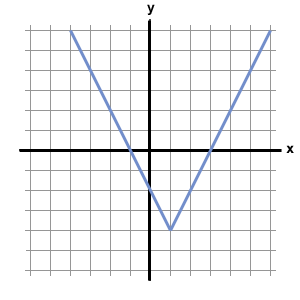All ACT Math Resources
Example Questions
Example Question #1 : How To Graph Complex Numbers
The point 


Because points on a graph are written in the form of 



In order to solve for 


We then solve the equation by finding the value of the right side, then dividing the entire equation by 5, as follows:
Therefore, the value of 

Example Question #12 : Graphing
The Y axis is a _______________ of the function Y = 1/X
Zero solution
Asymptote
Equation
Vertical slope
Asymptote
A line is an asymptote in a graph if the graph of the function nears the line as X or Y gets larger in absolute value.
Example Question #1 : How To Graph A Function
Which of the given functions is depicted below?

The graph has x-intercepts at x = 0 and x = 8. This indicates that 0 and 8 are roots of the function.
The function must take the form y = x(x - 8) in order for these roots to be true.
The parabola opens downward, indicating a negative leading coefficient. Expand the equation to get our answer.
y = -x(x - 8)
y = -x2 + 8x
y = 8x - x2
Therefore, the answer must be y = 8x - x2
Example Question #14 : Graphing
What is the domain of the following function:
x ≠ –1
x ≠ 2
x = all real numbers
x ≠ 5
x ≠ –2 and x ≠ –3
x ≠ –2 and x ≠ –3
The denominator cannot be zero, otherwise the function is indefinite. Therefore x cannot be –2 or –3.
Example Question #2 : How To Graph A Function
The figure above shows the graph of y = f(x). Which of the following is the graph of y = |f(x)|?
One of the properties of taking an absolute value of a function is that the values are all made positive. The values themselves do not change; only their signs do. In this graph, none of the y-values are negative, so none of them would change. Thus the two graphs should be identical.
Example Question #123 : Coordinate Geometry
Below is the graph of the function 

Which of the following could be the equation for 
First, because the graph consists of pieces that are straight lines, the function must include an absolute value, whose functions usually have a distinctive "V" shape. Thus, we can eliminate f(x) = x2 – 4x + 3 from our choices. Furthermore, functions with x2 terms are curved parabolas, and do not have straight line segments. This means that f(x) = |x2 – 4x| – 3 is not the correct choice.
Next, let's examine f(x) = |2x – 6|. Because this function consists of an abolute value by itself, its graph will not have any negative values. An absolute value by itself will only yield non-negative numbers. Therefore, because the graph dips below the x-axis (which means f(x) has negative values), f(x) = |2x – 6| cannot be the correct answer.
Next, we can analyze f(x) = |x – 1| – 2. Let's allow x to equal 1 and see what value we would obtain from f(1).
f(1) = | 1 – 1 | – 2 = 0 – 2 = –2
However, the graph above shows that f(1) = –4. As a result, f(x) = |x – 1| – 2 cannot be the correct equation for the function.
By process of elimination, the answer must be f(x) = |2x – 2| – 4. We can verify this by plugging in several values of x into this equation. For example f(1) = |2 – 2| – 4 = –4, which corresponds to the point (1, –4) on the graph above. Likewise, if we plug 3 or –1 into the equation f(x) = |2x – 2| – 4, we obtain zero, meaning that the graph should cross the x-axis at 3 and –1. According to the graph above, this is exactly what happens.
The answer is f(x) = |2x – 2| – 4.
Example Question #122 : Coordinate Geometry
Which of the following could be a value of 

The graph is a down-opening parabola with a maximum of 
Example Question #124 : Coordinate Geometry

What is the equation for the line pictured above?
A line has the equation




The 


The slope can be found by selecting two points, for example, the y-intercept and the next point over that crosses an even point, for example, 
Now applying the slope formula,
which yields 
Therefore the equation of the line becomes:
Example Question #1 : Graphing
Which of the following graphs represents the y-intercept of this function?





Graphically, the y-intercept is the point at which the graph touches the y-axis. Algebraically, it is the value of 

Here, we are given the function 


So the y-intercept is at 
Example Question #5 : How To Graph A Function
Which of the following graphs represents the x-intercept of this function?





Graphically, the x-intercept is the point at which the graph touches the x-axis. Algebraically, it is the value of 

Here, we are given the function 


So the x-intercept is at 
Certified Tutor
All ACT Math Resources


















































